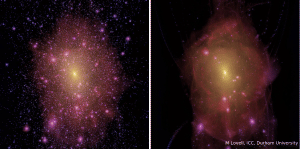Blog
Is Dark Matter Sterile?
9 July 2015

Is dark matter sterile? That’s one idea recently presented at the National Astronomy Meeting of the Royal Astronomical Society this week.
Dark matter is the enigmatic material that seems to dominate our universe. From its gravitational effects it seems to be about five times more common than the regular matter that makes up stars, planets, you and me. But since it doesn’t interact with light it has been difficult to observe directly. This has led some to propose modified gravity models to eliminate the need for dark matter, but this approach has been unsuccessful so far. Another approach is to propose some new kind of matter that could be dark matter, such as WIMPs or axions. But what if dark matter is a new variety of a known particle. This is where sterile neutrinos come into the game.
A neutrinos are a product of radioactive decay, and only interact with matter through the weak force. There are three known varieties of neutrinos, but because of their small mass and high speeds they cannot explain the effects of dark matter. But neutrinos have the unusual property that when they are produced they always spin in the same direction relative to their motion. This spin-motion connection is known as helicity, and in general can be right handed or left handed. If you imagine your thumb pointing in the direction of a particle’s motion, with your curled fingers representing the direction of the spin, then you can see which is which. Neutrinos are always formed with a left handed helicity.
Sterile neutrinos would have a right-handed helicity. Because of this they wouldn’t interact with regular matter (hence sterile). Depending on the model, they could theoretically have much higher masses than regular neutrinos, which could explain dark matter. In the recent presentation at NAM2015, a team looked at computer simulations of traditional cold dark matter models and sterile neutrino models. What they found is that sterile neutrinos seemed to be a slightly better match to observed galaxies.
While this is interesting, the sterile neutrino model is not without its problems. For example, there is cosmological evidence that points to the universe only having three neutrino varieties. Also, cold dark matter models remain the best match on large cosmic scales.